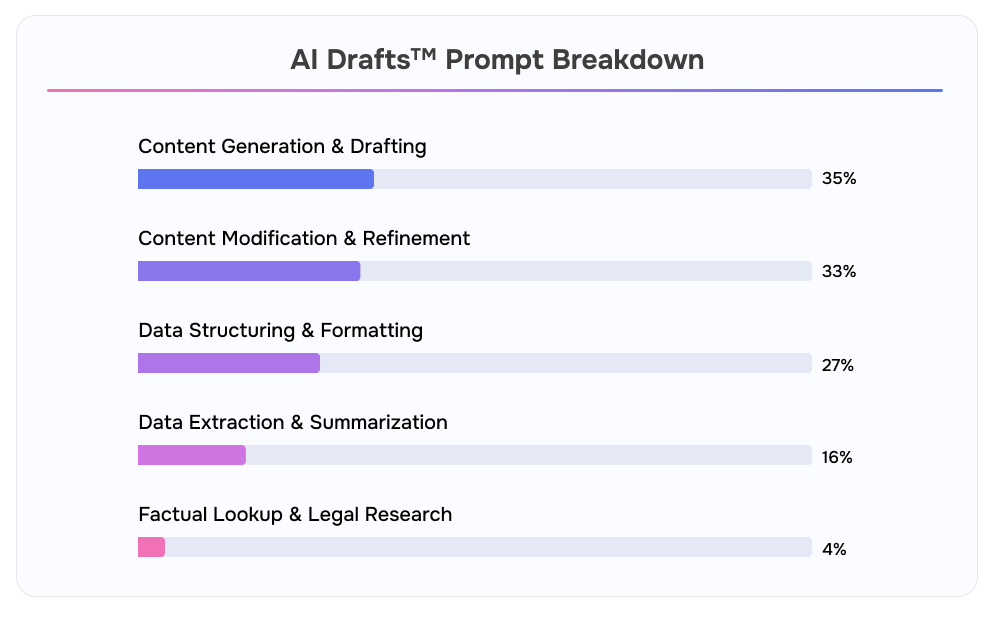Top PI Firms Are Drafting Documents in Minutes, Not Days
To understand how leading firms are prompting, we analyzed over 2,000 manually entered prompts from 200+ firms across EvenUp’s AI Drafts™ suite. The data tells a powerful story.
A clear pattern emerges: firms use AI to handle the heavy lifting of creating first drafts of legal documents as well as refining, structuring, and modifying case documents.
First Drafts with AI (Content Generation & Drafting)
Prompts for drafting and generating legal documents and communications make up 35% of total AI Drafts™ prompts.
This is where attorneys save the most time. Firms are prompting AI to generate lengthy and comprehensive legal documents, such as interrogatories, complaints, and discovery requests.
An example of this type of prompt includes:
Write a section to this letter summarizing the neurological, concussion, and TBI symptoms the plaintiff has been experiencing as a result of the subject accident.
Editing and Iterating with AI (Content Modification & Refinement)
Prompts for modifying and refining content are a close second, accounting for 33% of prompts.
Attorneys aren’t just generating content; they’re iterating on it. Prompts are being used to revise tone, strengthen arguments, and refine structure in seconds. Instead of rewriting from scratch, firms are asking AI to “make this stronger”, “simplify this section”, or “rephrase to sound more neutral”.
An example of this type of prompt includes:
Please rewrite it to indicate that the client is still in active treatment to address all of these injuries.
Messy Records to Organized Formats (Data Structuring & Formatting)
Requests about structuring and formatting data make up just over a quarter (27%) of AI Drafts™ prompts.
AI is also being asked to turn messy inputs into organized, court-ready outputs. This is especially useful for paralegals and case managers who need to standardize documentation with firm templates, organize exhibits, and more.
An example of this type of prompt includes:
Reorganize this document in bullet-point form, with points and subpoints. Organize treatment in chronological order. For each date of service, include the medical provider, subjective complaints, objective findings, assessment/diagnosis, and plan for treatment. Also, include any diagnostic tests and any positive findings. Finally, keep the citations
Document Overload to Legal Summaries (Data Extraction & Summarization)
Prompts for extracting and summarizing data account for 16% of prompts.
These prompts are used to summarize medical records, deposition transcripts, or email chains to surface critical details.
Examples of this type of prompt include:
Give me a one-page summary of the facts, insurance coverage, injuries, and treatments.
Review, analyze, and summarize the deposition transcript, identifying key admissions and important testimony relevant to [case specifics, e.g., liability, causation, damages].
Find Facts in Seconds (Factual Lookup & Legal Research)
While this is a significantly smaller share, 4% of AI Drafts™ prompts are for quick factual references and preliminary legal analysis, showing that attorneys still consider research to be a key part of legal strategy.*
An example of this prompt includes:
What negligence caused bodily injury resulting from the driver’s actions?
*This type of task is best handled by Case Companion™, EvenUp’s legal AI assistant, which we cover in a following article of the prompts series.
AI Provides the Hammer and Nails; You Just Have to Swing It
A simple takeaway from this analysis is that personal injury firms are going well beyond generating content. Legal professionals are using EvenUp to fine-tune drafts, format timelines or tables, and pull key insights; freeing up time and improving output quality.



